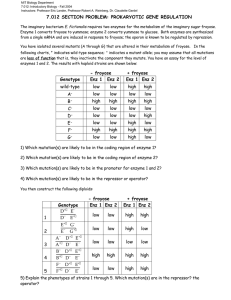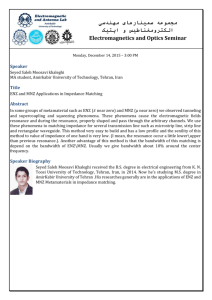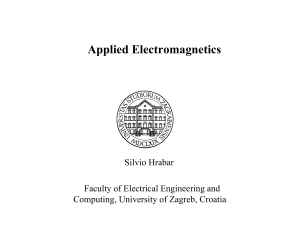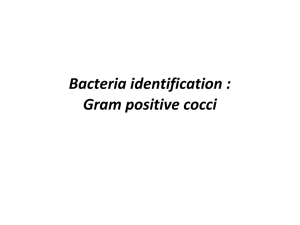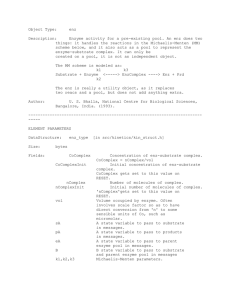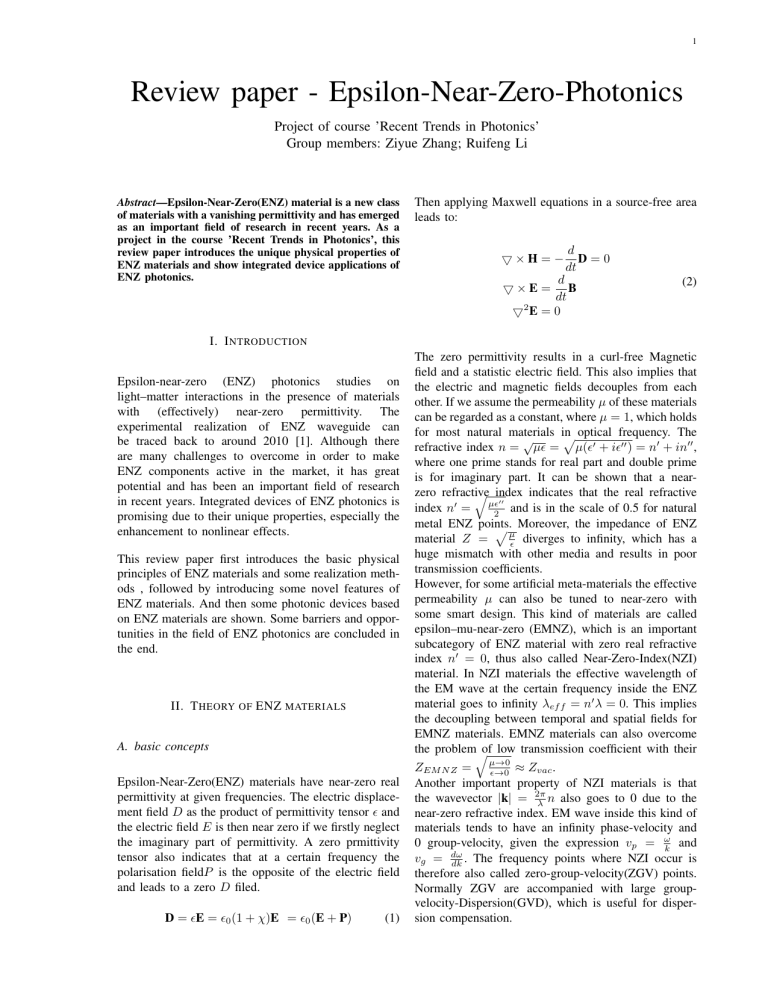
1 Review paper - Epsilon-Near-Zero-Photonics Project of course ’Recent Trends in Photonics’ Group members: Ziyue Zhang; Ruifeng Li Abstract—Epsilon-Near-Zero(ENZ) material is a new class of materials with a vanishing permittivity and has emerged as an important field of research in recent years. As a project in the course ’Recent Trends in Photonics’, this review paper introduces the unique physical properties of ENZ materials and show integrated device applications of ENZ photonics. Then applying Maxwell equations in a source-free area leads to: 5×H=− d D=0 dt d B dt 2 5 E=0 5×E= (2) I. I NTRODUCTION Epsilon-near-zero (ENZ) photonics studies on light–matter interactions in the presence of materials with (effectively) near-zero permittivity. The experimental realization of ENZ waveguide can be traced back to around 2010 [1]. Although there are many challenges to overcome in order to make ENZ components active in the market, it has great potential and has been an important field of research in recent years. Integrated devices of ENZ photonics is promising due to their unique properties, especially the enhancement to nonlinear effects. This review paper first introduces the basic physical principles of ENZ materials and some realization methods , followed by introducing some novel features of ENZ materials. And then some photonic devices based on ENZ materials are shown. Some barriers and opportunities in the field of ENZ photonics are concluded in the end. II. T HEORY OF ENZ MATERIALS A. basic concepts Epsilon-Near-Zero(ENZ) materials have near-zero real permittivity at given frequencies. The electric displacement field D as the product of permittivity tensor and the electric field E is then near zero if we firstly neglect the imaginary part of permittivity. A zero prmittivity tensor also indicates that at a certain frequency the polarisation fieldP is the opposite of the electric field and leads to a zero D filed. D = E = 0 (1 + χ)E = 0 (E + P) (1) The zero permittivity results in a curl-free Magnetic field and a statistic electric field. This also implies that the electric and magnetic fields decouples from each other. If we assume the permeability µ of these materials can be regarded as a constant, where µ = 1, which holds for most natural materials in p optical frequency. The √ refractive index n = µ = µ(0 + i00 ) = n0 + in00 , where one prime stands for real part and double prime is for imaginary part. It can be shown that a nearzero refractive q index indicates that the real refractive 00 0 index n = µ2 and is in the scale of 0.5 for natural metal ENZ points. p µ Moreover, the impedance of ENZ material Z = diverges to infinity, which has a huge mismatch with other media and results in poor transmission coefficients. However, for some artificial meta-materials the effective permeability µ can also be tuned to near-zero with some smart design. This kind of materials are called epsilon–mu-near-zero (EMNZ), which is an important subcategory of ENZ material with zero real refractive index n0 = 0, thus also called Near-Zero-Index(NZI) material. In NZI materials the effective wavelength of the EM wave at the certain frequency inside the ENZ material goes to infinity λef f = n0 λ = 0. This implies the decoupling between temporal and spatial fields for EMNZ materials. EMNZ materials can also overcome the problemqof low transmission coefficient with their ZEM N Z = µ→0 →0 ≈ Zvac . Another important property of NZI materials is that the wavevector |k| = 2π λ n also goes to 0 due to the near-zero refractive index. EM wave inside this kind of materials tends to have an infinity phase-velocity and 0 group-velocity, given the expression vp = ωk and vg = dω dk . The frequency points where NZI occur is therefore also called zero-group-velocity(ZGV) points. Normally ZGV are accompanied with large groupvelocity-Dispersion(GVD), which is useful for dispersion compensation. 2 B. realisation mechanism 1) Natural ENZ materials: The easiest approach to near-zero-epsilon is using those materials that can be described by Drude Model: ε(ω) = ε∞ − ωp2 ω 2 + iγω (3) where ε∞ is the permittivity at infinity large frequency; ωp is the electrostatic oscillation frequency (plasma free2 , N is the carrier density. When the quency) ωp2 = εN0 m e incident frequency equals to the bulk plasmon frequency √ of ω = ωo / ε∞ , the real part of epsilon becomes zero,indicating the existence of ENZ points. This type of ENZ behavior can be found over a wide frequency range from the ultraviolet to the mid-IR range, and even up to the THz regime. This broad band originates from the wide range of N in different materials. Metals are natural Drude-Model materials, but they have large imaginary permittivity ,indicating too much loss for most photonic systems. Thus the ENZ mode can only exist when the metal layer is extremely thin (in d¡10nm scale). Metals have ENZ points typically in the UV band. ENZ points in metals are rather fixed because their carrier density is difficult be tune. Degenerately doped semiconductors such as fused silica, Cadmium oxide, and Indium oxide are also used for ENZ materials, which are semiconductors with high dopant density. These semiconductors have large bandgaps and are transparent in visible range, and are called Transparent conducting oxides ”TCOs” [2]. TCOs can be heavily doped and are able to be described by Drude Model. In comparison with metals, Degenerately doped semiconductors have tunable carrier density and low damping rate γ, leading to more flexible ENZ points and lower loss(imaginary permittivity). The ENZ points in Degenerately doped semiconductors are normally in IR or MIR. However, the thickness of such materials must be smaller than the scale of 1 100 micrometers to support ENZ mode due to loss. The ENZ points in degenerately doped TCOs are observed in experiments and widely used in integrated photonics. Figure 1 [3] shows a comparison between theoretical and experimental values for permittivity in a film of ITO. Figure 1: Linear relative permittivity of the ITO film measured via spectroscopic ellipsometry and estimated by the Drude model. [3] There are studies focusing on the propagation modes in Sub-wavelength thin film ENZ materials showing that the ENZ mode is a part of long-range surface plasmonic wave mode [4] [5]. The semicondutor type of ENZ materials are easier to fabricate thanks to its reachable thickness and the mature semiconductor chip industry. 2) artificial ENZ materials by media mixing: Another way to obtain ENZ material is using multiple thin layers of plasmonic materials and dielectrics. Materials under long-wavelength approximation can be regarded as homogeneous materials with a constant effective permittivity εef f that can be determined by effective medium theory(Maxwell–Garnett equation) [5]: ⊥,ef f = dm m +dd d dm +dd 1 k,ef f = dm /m +dd /d dm +dd where dm and dd are thickness of metal and dielectric layers and εm and εd are permittivity of metal and dielectric layers. Dielectric materials with positive permittivity combining with electron gas materials with negative permittivity(when the frequency is below bulk plasma frequency) then enables ENZ points at a certain frequency in the artificial material. This kind of ENZ materials are manufactured by stacking thin layers of dielectric, metal, semiconductors or by inserting array of nanowires/nanonets into dielectric host. They are mostly inhomogeneous because of the broken symmetry compared with natural ENZ materials, meaning that they have ENZ points with limited incident angles. The ENZ points are now much more tunable because they are no longer determined by the carrier frequency but the fraction of layer thicknesses. They can also be easily fabricated by thin-film deposition techniques. media-mixing ENZ materials are promising in nonlinear 3 devices given these two advantages. For example, 5 nm silver layers are stacked with 70 − 80 nm SiO2 layers in order to produce an ENZ point around 800 − 900 nm wavelength [6]. 3) artificial ENZ materials Operating at Cutoff Frequency: Metallic Hollow Waveguides with specific designs can also enable ENZ points in their spectrum. Unlike dielectric waveguide with cutoff frequency βcutof f = nmin k0 , metallic waveguides with perfect electric conductivity(PEC) boundaries have cutoff frep π 2 k2 − ( w ) = 0, where w is the quecy at β = dimension of a 1D metallic hollow waveguide. EM waves at the fundamental T E10 cutoff frequency of the waveguide has zero propagation constant β 2 = k02 − kx2 = 0 and can be regarded as having a zero effective refractive index; a zero group velocity; a zero effective permittivity. Therefore, a metallic hollow waveguide can provide an ENZ point avoiding the requirement of negative permittivity. 4) artificial ENZ materials Operating at the Centre of the Brillouin Zone: The name ’Dirac Cone’ originates from Semiconductor Quantum physics, where electrical conduction can be described by the movement of charge carriers which are massless fermions(in another word, the effective mass of eletrons are 0 at Dirac points). The Dirac points also indicates linear dispersion relation between electron energy and the crystal momentum in a 2D model . This concept can certainly be extended to 2-D photonic crystals as ENZ points, with linear dispersion relation between photon frequency and photon momentum in photonic crystals. When this Dirac point is at the centre of the Brillouin zone where the wavevector k =0, an isotropic(regardless of incident angle in the 2-D plane) ENZ point is enabled in the photonic crystal. This structure is implemented in 2015 [7] with short silicon pillars between parallel conductors. The photonic dirac cone is shown in figure 2 III. NOVEL PHYSICAL EFFECTS OF ENZ MATERIALS As shown in the previous section, ENZ materials have many unique properties due to the singularity in its parameter space. In this section several important novel effects of ENZ materials are introduced. A. normal emission Any light wave incidents from an ENZ material should be nearly normal to the surface after refracting due to Snell’s Law with nEN Z ≈ 0, as shown in fig 3 1 on the left. The right hand side of fig 3 demonstrates the reciprocal effect: the coupling tolerance becomes very critical because a near-zero refractive index makes most wave incident on the ENZ material suffer from TIR. Figure 3: normal refraction of ENZ material nenz sin θenz = n sin θinc (4) This effect can be useful when designing for example a surface emitting laser. This effect can also be used to easily identify an ENZ material. B. Transmission with Invariable Phase An EM wave can maintain its phase when propagating through an ENZ material simply because k = 2π λ0 n = 0 and E = E0 ejk·r = E0 . This constant phase remains all over the ENZ region, which can cause constructive or destructive interference with other waves inside the ENZ material. Thus, when there are multiple in-phase sources inside the ENZ material, they will constructively interfere at everywhere. This effect is useful when designing micro-antennas. Figure 2: photonic Dirac Cone of the photonic crystal structure [7] 1 this is and original drawing and is not from any literature 4 C. Field amplification Considering the boundary conditions of Maxwell equation: n·D should be continuous on the boundary between ENZ material and another dielectric material, where n is the unitary normal vector. This means that the normal component of electric field inside ENZ materials can be amplified significantly due to the vanishing |E | . However, this amplified permittivity: |E⊥ | = 0,⊥ field can only exist as a surface wave mode because of TIR, the proporgating mode is also called ’ENZmode’ or ’long-range surface wave mode’ . This effect is usually implemented in sub-wavelength thin film ENZ devices and is very important for enhancing non-linear phenomenons. the ENZ material due to Snell’s Law as explained in the section [normal emission]. On the other hand, all light waves will experience the same phase front diffusion and enables phase modulation of emission by designing the geometry of the exit ENZ surface as shown in figure 4. D. benefits to non-linear phenomenons Nonlinear optics play an important role in the photonic community. Nonlinear phenomenons becomes significant with two restrictions, namely phase-matching and high incident intensity. Luckily ENZ benefits for both aspects of nonlinear optics. Firstly, when there is phase mismatch, there will be constructive interference in the entire ENZ region among the nonlinear dipoles which are in different locations, instead of destructive interference in non-ENZ materials. Thus, ENZ material tends to be ’phase-mismatch-free’. Secondly ,high input intensity is not needed to obtain the strong field distribution required for the nonlinear processes due to the unique electric field enhancement mechanism introduced in the last section. Moreover, the group velocity of EM waves in ENZ materials tends to be zero in a certain frequency, which leads to long propagation time inside ENZ material and earns more time for nonlinear-optic interaction. ENZ materials have enormous advantage in nonlinear optics and is promising for integrated nonlinear devices by enhancing effect on nonlinear effects. Using ENZ materials to make frequency variation devices can obtain more outstanding functions. Figure 4: an ENZ material can modulated the emitted phase front [2] B. All-Optical Switching Based on its remarkable characteristics, ENZ materials have shown potential in the following application fields. In the integrated optical circuit, the optical logic gate is the most basic element to realize the ultra-fast optical network on the chip. This optical logic gate can be realized by All-Optical Switching technology based on ENZ material. The third-order optical nonlinear effect induces a change of the optical refractive index which can be directly used to realize the all-optical switch. NRZ material has low linear permittivity in zero-epsilon region. The relationship between refractive index and light intensity can be approximately expressed as n = ∆n · I. The relationship between linear permittivity √ . and the change in refractive index ∆n is ∆n = ∆ Therefore, the use of ENZ materials can not only make the refractive index zero when the light intensity is small, but also obtain a large gain rate, which means that a small increase in light intensity can greatly change the refractive index. Such characteristics can well realize the distinction between the ’0’ state and the ’1’ state of an optical switch. In addition, as mentioned above, ENZ material itself is easy to achieve nonlinear effects, which is also beneficial to the realization of all-optical switches. A. Directed Emission Devices C. Nanoinsulators For modern emitters, manipulation of the direction and phase front of the emitted field are the goals that people continue to pursue. On the one hand, the EM wave will be in the normal direction of the surface when it leaves Conventional circuits operating in the RF domain contain elements smaller than the operating wavelength, based on which Engheta et al proposed a new concept ‘nanocircuit and nanoelements operating in the IV. ENZ BASED INTEGRATED DEVICES 5 optical domain’ in 2005 [8]. In such an optical circuit, due to the change of optical characteristics in a high frequency regime, the conducting current is no longer the current flowing in the optical device. Instead, the electric displacement vector D derived from Maxwell’s equations can be regarded as a ’flowing optical current’. In nanocircuits, sub-wavelength particles can be synthesized into nanoinductors, nanocapacitors and nanoresistors. The electric displacement vector in the ENZ material can be regarded as zero, so the ENZ material can be used as a nanoinsulator. V. OPPORTUNITIES AND OBSTACLES The development of ENZ materials still faces extreme challenges. First, the inherent loss near the ENZ point still needs to be reduced or eliminated. This inherent loss will cause absorption and deformation of the signal in the ENZ device, which makes the ENZ device unable to be cascadely connected. The second challenge is that currently ENZ can be only implemented in a narrow bandwidth. This means that WDM technology is difficult to use on ENZ devices, and some nonlinear effects can not benefit from ENZ materials. Finally, the on-chip integration method is also a key issue waiting to be solved. At this stage, there is no complete industrial chain that can be used to realize the integration of ENZ, which leads to its high cost. VI. CONCLUSION ENZ materials have great potential in photonic devices. Content of this report is restricted by total words limitation but ENZ photonics have a much larger variety of applications than what is demonstrated here. To wrap up, several important features about ENZ materials are explained in section III based on some simple mathematical deduction in the theory section II. Some modulation devices made use of ENZ materials are listed. The limitations and expected future studies of ENZ materials are shown. R EFERENCES [1] B. Edwards, A. Alù, M. E. Young, M. Silveirinha, and N. Engheta, “Experimental verification of epsilon-near-zero metamaterial coupling and energy squeezing using a microwave waveguide,” Physical review letters, vol. 100, no. 3, p. 033903, 2008. [2] X. Niu, X. Hu, S. Chu, and Q. Gong, “Epsilon-near-zero photonics: A new platform for integrated devices,” Advanced Optical Materials, vol. 6, no. 10, p. 1701292, 2018. [3] M. Z. Alam, I. De Leon, and R. W. Boyd, “Large optical nonlinearity of indium tin oxide in its epsilon-near-zero region,” Science, vol. 352, no. 6287, pp. 795–797, 2016. [4] S. Campione, I. Brener, and F. Marquier, “Theory of epsilonnear-zero modes in ultrathin films,” Physical Review B, vol. 91, no. 12, p. 121408, 2015. [5] O. Reshef, I. De Leon, M. Z. Alam, and R. W. Boyd, “Nonlinear optical effects in epsilon-near-zero media,” Nature Reviews Materials, vol. 4, no. 8, pp. 535–551, 2019. [6] R. Kaipurath, M. Pietrzyk, L. Caspani, T. Roger, M. Clerici, C. Rizza, A. Ciattoni, A. Di Falco, and D. Faccio, “Optically induced metal-to-dielectric transition in epsilon-near-zero metamaterials,” Scientific reports, vol. 6, p. 27700, 2016. [7] Y. Li, S. Kita, P. Muñoz, O. Reshef, D. I. Vulis, M. Yin, M. Lončar, and E. Mazur, “On-chip zero-index metamaterials,” Nature Photonics, vol. 9, no. 11, pp. 738–742, 2015. [8] N. Engheta, A. Salandrino, and A. Alu, “Circuit elements at optical frequencies: nanoinductors, nanocapacitors, and nanoresistors,” Physical Review Letters, vol. 95, no. 9, p. 095504, 2005.
